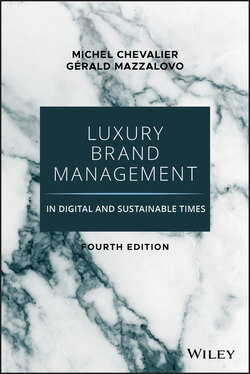Читать книгу Luxury Brand Management in Digital and Sustainable Times - Michel Chevalier - Страница 24
The Three Scales
ОглавлениеAn answer can come from a very relevant study, led by de Barnier, Falcy, and Valette-Florence, on a sample of over 500 persons in France. It allows synthesizing the values currently associated with luxury by consumers. This investigation offers the interest to compare three independent scales of value that explored the perception of luxury by consumers done by Kapferer,13 Vigneron and Johnson,14 and finally by Dubois et al.15
The statistical convergence of the three models highlights four main types of values, which we classify by order of intensity. In fact, we may recognize here four essential dimensions that consumers consider to be essential for a brand to belong to the luxury world.
1 Elitism (“distinction,” “select”) is the dimension most present simultaneously on the three scales. The historical social dimension of luxury still plays its role fully as an indicator of social success—or a simulacrum of that success. The creation of a sense of belonging to a selected group appears as the essential experience dimension. The creation of a feeling of belonging to a chosen group appears to be the essential dimension of the experience.
2 Unsurprisingly, product quality and high prices are also significant characteristics. The concept of quality can extend to all brand manifestations such as communication, real and virtual places, people, and so on.
3 In the third position we find personal emotional and affective elements, such as hedonism, but with a weaker correlation. This is the generation of pleasure and emotions, key components of postmodern consumption, which applies here to luxury brands.
4 Finally, the power of the brand (resulting from past decisions and actions) appears at the side of reputation and uniqueness.
Through this exercise, the consumer himself gives us his own definition of luxury. And although the fundamental intuition of sociologists (distinction) is confirmed, we discover that the consumer is not less attentive to the means of production of the luxury object and brands than to its personal and social impacts (see Figure 1.4). Yet again, luxury cannot be reduced to its sole effects of display.
Other considerations can be drawn from this study.
First, most consumers think and live luxury only in terms of brands. Could luxury be experienced outside of the brand world? We could refer to the imaginary world of two French novels, À Rebours16 and Les Choses17: two portraits of characters, consumers obsessed by luxury. In both cases, the brands are absent from their universe: it is the quality of the products that holds their attention. Today, on the contrary, brands appear as the natural vehicles by which luxury plays its primary role in postmodern consumption.
Secondly, each brand develops its own specific strategies, which do not necessarily cover the four sectors of our analytical scheme.
Figure 1.4 Positioning of the Definition of Luxury Given by Consumers
Finally, the study of de Barnier, Falcy, and Valette-Florence demonstrates the existence of a continuum of luxury with increasing intensity, from mass luxury to unaffordable luxury, via intermediary luxury.
